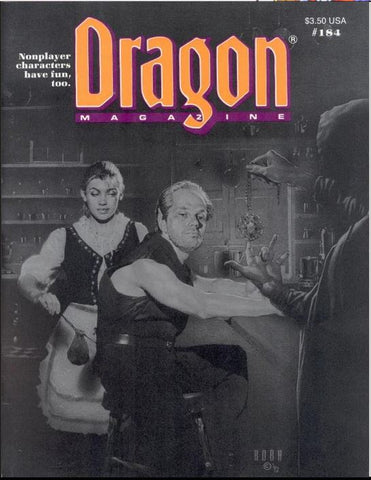TSR’s Dragon Magazine, over the years, proposed and developed a variety of classes, monsters, gods, and characters for Dungeons and Dragons. It also created a great deal of resources for dungeon masters. And Dragon Magazine #184, published in August 1992, focused on something that every dungeon master uses. Non-player characters, better known as NPCs.
The edition included an array of articles designed to assist in creating, developing, and including various kinds of NPCs for campaigns. They suggested ways to make interesting enemies, streamline the creation process, and pre-created courtiers for royal courts. One of these articles, written by Scott Sheffield, was shortly titled You Again!
The Ideas and Content of You Again

The purpose of You Again? was to provide dungeon masters with ideas and guidelines for creating a nemesis (or multiple nemeses) for their parties.
It begins with an example: Grub, the gnome thief, stealing a valuable jewel and getting away seemingly scot-free. Alas, he doesn’t realize that he’s actually stolen from a dangerous cult, and earned himself a strange and elusive foe – one he won’t shake easily. Aside from the example story written out for the reader, the article speaks about designing a recurring NPC to complement and challenge the party. This can result in various styles of NPCs, from a noble lord who calls an adventurer to a duel, to a rival rogue who beats the party to their loot, to a scheming politician who spreads malicious rumors about the players.
To increase excitement upon their appearance, you’ll want to make them memorable, with a couple of notable traits like unusual appearance or speech patterns, and dedicate a consistent miniature to their portrayal (if you use them). These characters should be used carefully, however, the article advises. You’ll need to keep them alive to ensure that they can actually fill their role as a nemesis, balancing your players’ excitement at seeing a familiar figure with their frustration when they must inevitably fail to rid themselves of them once and for all. Once your players begin to tire of their rival, it’s best to allow them to finally best them. You can always introduce someone even more dangerous to the mix after their fall.
Is the Article Still Relevant?
Yes, of course, You Again? is still relevant to modern day players!

The tropes of rivals, nemeses, and recurring enemies are still popular characters that appear in novels, movies, and television today, and are consequently popular to appear in tabletop campaigns.
They don’t appear often in pre-written and published campaigns (perhaps because such characters work best when they can be tailored to individual parties, which pre-written campaigns cannot account for), but home games have the potential to make excellent use of them. Even some of the suggestions given in the article itself are great ways to incite pseudo-outrage and competition in your players.
The rumors that might be spread about the players are particularly funny. The idea that an honorable paladin has cheated in the joust that he just spent a fun-filled session winning is sure to spark some animosity in his player, of course. But the idea that this same honorable paladin has secretly fathered love children with the wife of a powerful lord is equally strange, and likely to get laughs from the rest of the gang.
How to Use this Content in a Current Campaign
Most of the suggestions found in You Again? can be taken wholesale and put into any home campaign without too much change. The article was written with AD&D in mind, but doesn’t provide any stat blocks or actual rules, so it doesn’t require adjustment for the differing editions that you might be using.
Here are a few suggestions for rivals/nemeses that the Sheffield prompts throughout the article (somewhat expanded upon in places):
-
A high priest of a powerful cult, whose lackeys range from street thugs to spellcasters. This rival favors underhanded tactics to take revenge for those who steal from or otherwise interfere with his cult. Followers of this particular dark faith could be anywhere, and anyone, even a trusted ally the party thought they could trust! Poisoning, malicious rumors, and ambush attacks are hallmarks of his appearance in a campaign.

- A trader who specializes in foreign herbs, who always appears dressed in the distinctive garb of those distant countries. The appearance of monsters along certain trade routes is beneficial to her, since she alone has access to safer avenues, and she doesn’t appreciate any adventuring party who clears those monsters away. Her tactics might include framing the party for criminal activity, paying thugs to attack them, or secretly strengthening the monsters in some way.
-
A baron’s daughter who favors a rival adventurer, was spurned by the party for some reason, or otherwise disdains the group. She’s arrogant and pompous, and generally disliked, but with plenty of political connections. She would favor interfering in ways that are more hands-off. Framing a party member for an illicit affair, having them arrested and thrown in a castle dungeon, or getting them banned from popular taverns and job-finding locations are all sure ways to irritate the party.

- A dexterous and malicious rogue of some renown in the local thieves’ guilds, whose targets have more than once coincided with some goal of the party. Maybe they beat him to his prize one too many times, or maybe he just finds that they lead him right to the coolest magical artifacts. This nemesis doesn’t want to kill the party, just show them up, and will swoop in at the last minute to take their hard-earned loot, or claim the glory for their latest quest.
Have you ever given your party a nemesis? How did it go? Did they love or hate them, or both? Let us know in the comments below!





